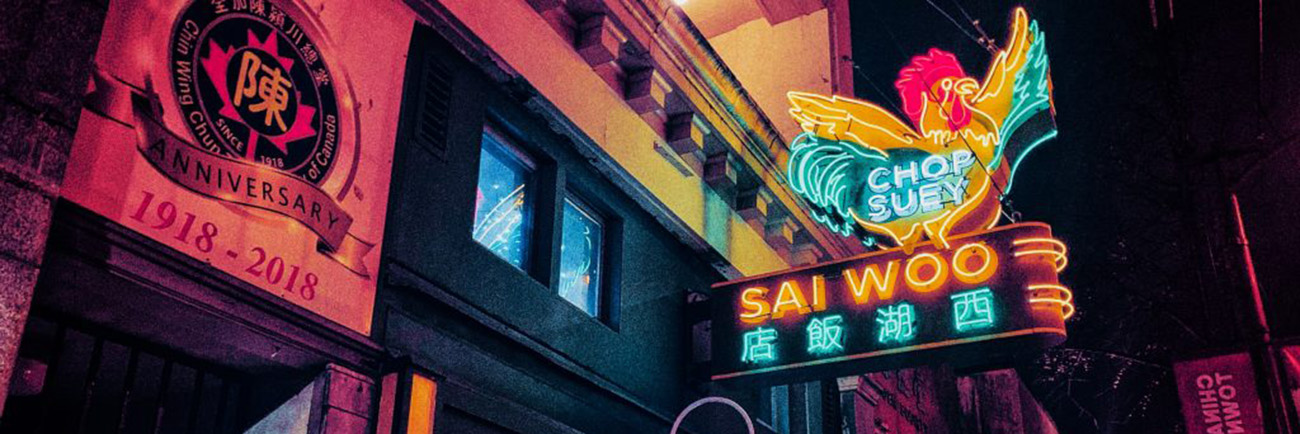VocalEye is delighted to partner with Griffin Art Projects to present highlights of their recent exhibit, Whose Chinatown?, a virtual art tour with Jessa Alston-O’Connor.
Chinatown neighbourhoods are a mainstay in most larger cities across North America, and came about out of necessity largely due to difficult racism towards Asian people in the 19th and 20th centuries. These thriving neighbourhoods became important hubs for safety, business, culture and community. Many people don’t know why Chinatowns exist, or how long Asian people have in fact been part of Canadian society. The first Chinese actually came over in the mid 1700s, and have roots here longer than many European immigrant communities.
Whose Chinatown? brings together an art history of Chinatowns and their communities. Drawing from private collections in Vancouver and across Canada, this exhibition aims to question how narratives are constructed around the idea of Chinatown and the colonial notions that underwrite some of these relations. Whose Chinatown? offers the perfect opportunity to celebrate the stories, the people and the culture that enrich and enliven our cities.
Curator’s Statement
Through my installation work where I recreate spaces such as the Chinese restaurant, karaoke lounges, opium dens, Chinatown curio shops, and other sites of cultural encounters, I look at how the corporeal experience of space allows one to understand its history and community. In works such as Terra dos Chinês Curio Shop (2015) and Miss Chinatown (2009), I deconstructed and reconstructed different ‘ethnic spaces’ to see which elements signify meaning for the public and thus, play a role in influencing Western perceptions of the Chinese, or the Other. Using a cultural studies framework, I invite a critical view of contemporary chinoiserie, the impact of the Chinese export trade, and goods produced for the ‘Western’ taste. The fascination with the East dates back the days of the Silk Road, and even at the height of chinoiserie as the Western market was being flooded with Chinese products, Chinese people overseas were targeted by racist laws and deemed unassimilable aliens. I am questioning and playing off notions of authenticity and the copy by producing my own fake antiques. These are based on the East Asian and chinoiserie objects in various museums, local collections, and eBay, using everyday materials and methods (seemingly genuine jade ornaments are sculpted out of soap, porcelain is fashioned out of papier-mâché, and silver objects created out of aluminium trays, etc.). This hopefully highlights the encounters that occur between specific locales and East Asian-influenced material culture and refer not only to mass production of pirated consumer goods in China but also to the questions that are always present where artistic production is concerned.
A deep engagement with archival and collections research has led me to question whose histories get to be collected and told, and to interrogate the narratives that have been constructed around the Chinese diaspora. How do we remember, represent, support, and simultaneously deny the erasures of our stories, spaces, and community? If there are minimal traces of the existence of an individual or organization, what are ways that this life can be made visible again? By actively bringing to light overlooked aspects of Chinese Canadian communities and culture through my artwork, my intent is to create counterpoints to accepted canons, official histories, public archives and collections. –Karen Tam
The VocalEye virtual lobby opens at 6:30 pm Pacific Time for some socializing and community updates with host Amy Amantea. The pre-show introduction will begin at 6:45 pm with Amy and Jessa. The show begins at 7 pm with a running time of approximately 90 minutes, including conversation, Q and A and a prize draw.
Register here for your VocalEye Zoom invitation or call 604-364-5949.
Karen Tam is an artist whose research focuses on the various forms of constructions and imaginations of cultures and communities, through her installation work in which she recreates spaces of Chinese restaurants, karaoke lounges, opium dens, curio shops and other sites of cultural encounters. Since 2000, she has exhibited her work and participated in residencies in North America, Europe, and China, including the Deutsche Börse Residency at the Frankfurter Kunstverein (Germany), Musée d’art contemporain de Montréal(Canada), He Xiangning Art Museum (China), and Victoria and Albert Museum (UK). She has received grants and fellowships from the Canada Council for the Arts, Conseil des arts du Québec, and Social Sciences and Humanities Research Council of Canada. Tam was a finalist for the Prix Louis-Comtois in 2017 from the Contemporary Art Galleries Association and the Ville de Montréal, a finalist for the Prix en art actuel from the Musée national des beaux-arts de Québec in 2016, and long-listed for the Sobey Art Award in 2016 and 2010. Her works are in museum, corporate, and private collections in Canada, United States, and United Kingdom.
Tam lives and works in Montréal and holds a MFA in Sculpture from The School of the Art Institute of Chicago and a PhD in Cultural Studies from Goldsmiths (University of London). She is a contributor to Alison Hulme (ed.) book, The Changing Landscape of China’s Consumerism (2014) and to John Jung’s book, Sweet and Sour: Life in Chinese Family Restaurant (2010). She is represented by Galerie Hugues Charbonneau.
“The theme for Asian Heritage Month 2021, Recognition, Resilience, and Resolve, embodies the myriad of sentiments that peoples of Asian descent in Canada have experienced and honours their contributions and their diverse stories which are rooted in resilience and perseverance. It is also a call to action for all Canadians to come together to combat all forms of anti-Asian racism and discrimination. Let us celebrate the incredible diversity that is our strength and be resolute in our stand against all forms of anti-Asian racism and discrimination.” –Heritage Canada







